
views
- Hold your cat on its back and grab one of its paws in your hand.
- Press gently on your cat’s paw to spread its toes out.
- Clip 1 nail at a time with nail clippers, trimming just the tips of the nails off.
Trimming a Cat’s Nails by Yourself

Wait until your cat is calm and relaxed. Pick a time when your cat is feeling nice and relaxed, like when it’s just getting up from a nap, getting ready to nap, or calmly resting on its favorite surface during the day. Don't try to trim your cat's nails right after play time, when it’s hungry, when it's restless and running around, or in an otherwise aggressive mood. Another good time for nail trimming is after your cat has eaten and is feeling sleepy and content. You may see that your cat has a broken or splitting nail and will want to cut it instantly, but hold off. Make a note of it and wait for your cat to get relaxed before trying to cut it, or you could make the nail worse.
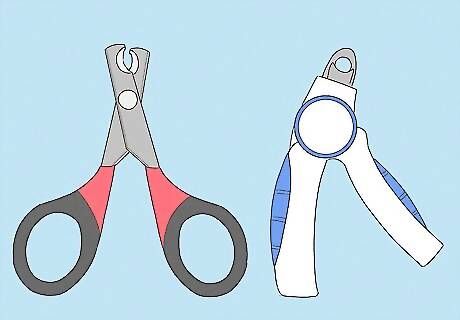
Use nail clippers designed for a cat. Before sitting down to cut your cat’s nails, be sure you have the right equipment to do so. To trim your cat's nails, use a pair of nail clippers designed to clip cat claws and a styptic pencil. Choose from 2 different styles of nail clippers: scissor clippers and guillotine clippers. Scissor clippers cut a cat’s nails using a scissor motion and usually come in small and large sizes. The small “nippers” tend to be better for those new to clipping nails or if you just need to snip the tips. [1] use a sliding blade that cuts the nail when you squeeze the handles together. The claw fits into a slot and the blade slides across to clip the nail. These are strong clippers that are good for cutting long, thick nails. Clippers don't stay sharp forever, so discard them (or send them for sharpening) if you suspect the blades have gone dull. Signs of this include having to apply a lot of pressure to cut the nail or the nail being “chewed” by the clippers rather than making a clean cut. Styptic pencils cauterize blood vessels when touched to the nail and help prevent bleeding. If you cut the quick, hold the styptic pencil to the claw for 1 - 2 minutes to stop the bleeding.
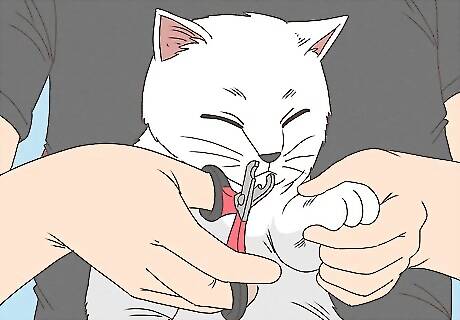
Hold your cat on its back with its rear on your lap. Hold the clippers in one hand and hold your cat’s paw in the other. Gently squeeze the top and bottom of your cat’s paw, on the joint just behind the claw to extend the claw. If your cat doesn’t like this position, hold it in the crook of your arm instead. If you need to trim your cat’s nails but it's putting up a fight, wrap the cat in a towel or blanket and extend one arm or leg out at a time. Start with the back claws first. Many cats will try to use their hind legs to get free, but if you've already cut them, you won't get scratched as easily.
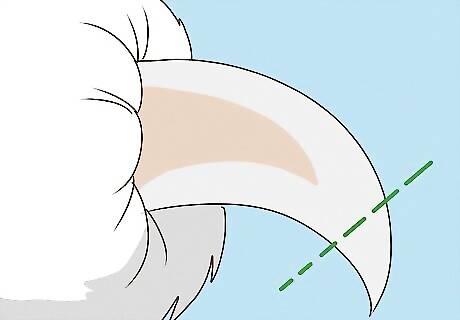
Find the place where the nail separates from the quick. Be sure you know where the quick is before you attempt to cut the nail—the quick will look like a small, pinkish triangle inside the nail. Take note of where this is on your cat’s nail so you can avoid clipping it. Try to orient the clippers so that when the nail is cut, the blade cuts from bottom to top. This will help prevent splitting. First cut just the tip of the nails. As you get more comfortable, you can cut closer to the quick, but never cut all the way to the quick or you can hurt your cat and make its nails bleed.
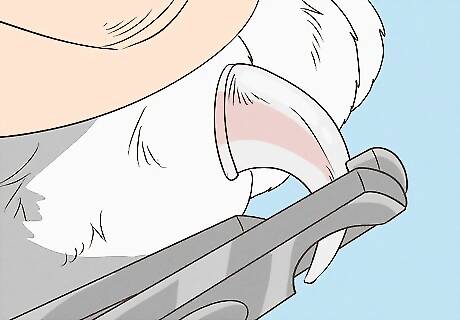
Cut the nails with the trimmers. Hold your cat firmly and cut the nails one by one. Position the trimmers halfway between the end of the quick and the claw. Snip slowly, and speak to your cat in a calm, soothing voice the entire time. Try to avoid getting frustrated. Your cat may protest, meow, and try to scratch you, but don't yell at your cat or rush through the process, or you may end up hurting it and scaring it away having its nails trimmed again. You may only be able to trim one or two nails at a time at first, which is okay. Your cat’s comfort matters the most. Don't forget the dewclaws! Most cats have 2 dewclaws, one on each front leg. These are like a small thumb, located on the side of the front legs, just below the wrist. Check these monthly and cut them if they’re too long.

Give your cat a treat. It’s been a good sport about letting you cut its nails, and now your furry friend deserves a reward! Make the treat special: vacuum-packed salmon, or chicken. Some cats also like sour cream or butter. Over time, your cat will associate getting its nails trimmed with getting a treat. Though your cat may not love the nail-trimming part, it'll want the treat afterwards, so it'll be less resistant in the future.

Check your cat's nails every 2 to 4 weeks. Each cat's nails grow at a different rate, but it's a good rule of thumb to trim your cat's nails somewhere between every 2 weeks and every month so that its nails don't get too long, split, or break. Though your cat will be sharpening its claws and keeping them in good shape on its own, keep an eye on their nails nonetheless. Your cat could be walking around with a broken nail, and you can help it out by trimming it into shape. Older cats need special attention because their nails are thicker and can sometimes press around into the pads, cutting into them. Check your older cat's nails every week and clip the tip off if necessary. If your cat’s nails cut into their pads, take them to a vet.
Preparing Your Cat
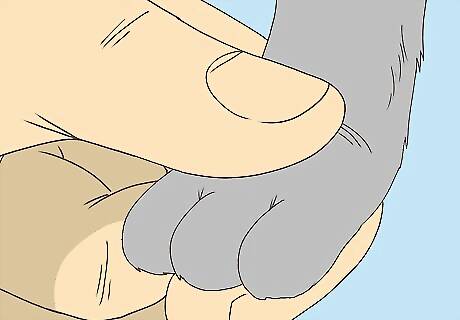
Pet your cat’s paws. Most cats are naturally a little skittish about having their paws handled, so begin by helping your cat get accustomed to it. Wait for a time when your cat is relaxed and lounging. Begin gently petting its paws while simultaneously petting the cat in its favorite spots (the back of the neck, under the chin, where its back meets its tail, etc.). Do this for each paw you plan to trim. The cat might pull its paws away, or even get up and walk away. Let it go; don't force it to do anything, but continue to gently pet its paws when you have the opportunity. Whenever you handle your cat’s paws, reward it with treats and praise to help build positive associations.
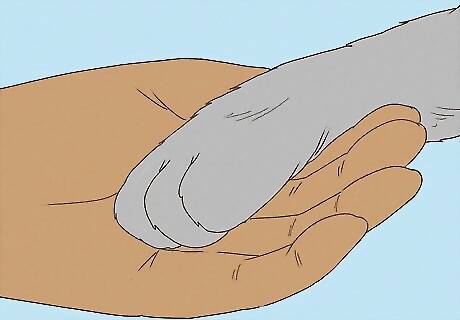
Hold your cat’s paws. Once your cat is comfortable enough to allow you to rest your hand on its paws without pulling away, start to gently hold its paws in your open hand. Place your hand over the cat’s paw, then flip your hand around so the bottom of the cat's paw is on the palm of your hand. Keep rewarding the cat with petting and treats; give the cat a new, special treat that will only be associated with cutting its claws. You can condition your cat as a kitten—even as young as a month old.
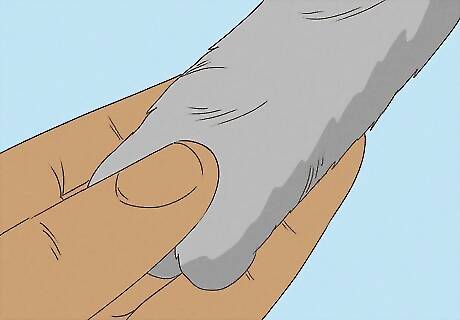
Massage your cat’s paws. After your cat grows accustomed to you holding its paws, start holding the paws and massaging them with your fingers. Gently massage your fingers over the tops and bottoms of each paw you plan to trim. Reward your cat with more treats and praise.
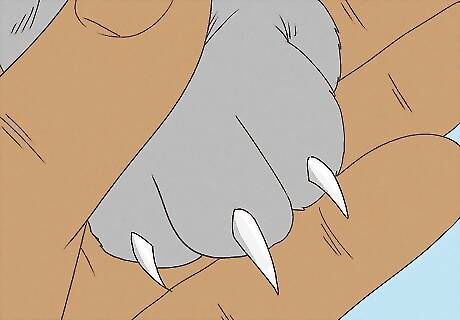
Look closely at your cat’s nails. Eventually, you should be able to gently squeeze the paws (applying most of the pressure on the pads) to push individual claws out without upsetting your cat. When your cat’s claws are extended, you’ll see the thick part of the nail, and, towards the cat’s toe, a pinkish area inside the nail, called the quick. The quick is the living part of the nail and contains blood vessels and nerves, so cutting a cat’s nail to the quick is quite painful for the cat. Never cut a cat's nail close to or with flush with the toe; your aim is to clip off only the sharp point. Look carefully at where and how large each quick is—through a clear nail it will look like a small pink triangle. Each of your cat’s nails will be similar, so even if the cat has dark nails, look to find one clear nail as a reference point for the others.
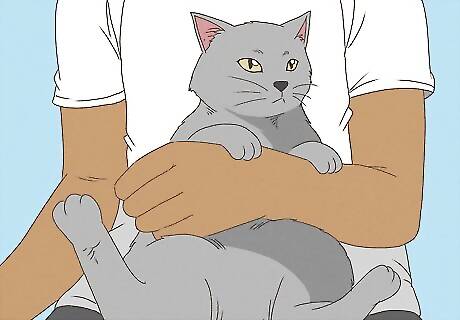
Get your cat comfortable with the “nail-trimming position.” If your cat is already comfortable sitting in the right position to have its nails cut, it will put up less of a fight during the actual trimming. If you're going to be trimming the cat's nails by yourself, the cat will need to sit on its rear on your lap, facing away from you, while you hold its paw with one hand (and, eventually, the clippers with the other). Practice having your cat sit this way and hold each of its paws. Gently press on each nail to extend it. Again, reward the cat with treats and praise. If you have someone to help, they can hold the cat facing you, or they can cradle it, while you hold the paw with one hand (and, eventually, clip with the other). Practice having your assistant hold your cat while you hold each of its paws and gently press each claw until your cat seems comfortable. Reward it with treats and praise.
Trimming Your Cat’s Nails with Help

Choose a person your cat knows and trusts. Don't get a stranger or relative stranger to help you trim your cat's nails, or your cat will be even more scared. Though it sounds good and fine to get your cat used to having its nails trimmed, the reality is, many cats will still protest every single time, and you may have to get some extra help to do it.

Have your helper hold the cat in place. Try standing on opposite sides of a raised surface, like a counter. Talk calmly and reassuringly to calm your cat down. Have your helper pet the cat and try to keep it in place by holding on to its body without hurting it or scaring it too much. If your cat enjoys being brushed, have the other person brush the cat to distract it from the fact that it's getting its nails trimmed. Have your helper brush the cat’s head, under its neck, or in other places where it enjoys being brushed.
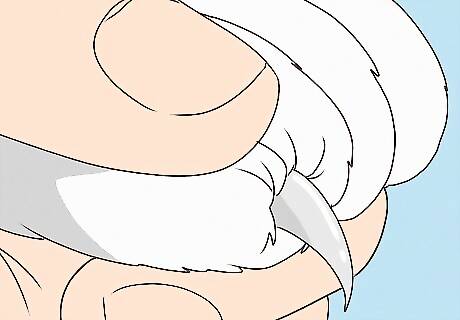
Hold one of your cat's paws in your hand. While holding the paw, push down on the pad to extend the claws. If your cat is being rowdy, wait for it to settle down so that you can isolate the paw.
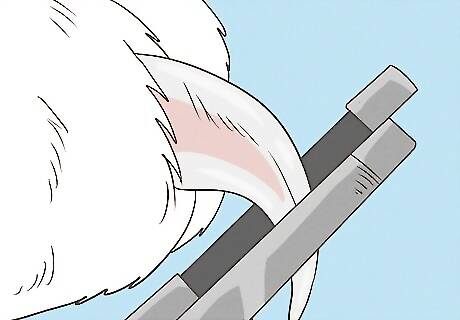
Trim your cat's nails as you normally would. Have your helper continue to distract the cat while you trim its claws. Follow the directions in the previous section to make sure you give your cat a smooth, painless nail trim. When you're done, reward your cat with a nice treat.
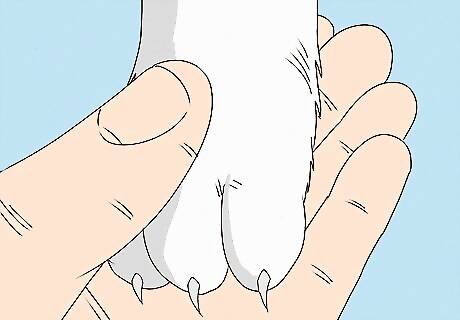
Check your cat's nails on a regular basis. Every cat's nails will grow at a different rate, but it's good practice to trim your cat's nails somewhere between every 2 weeks and every month so that its nails don't get too long, split, or break. Though your cat will likely sharpen its claws and keep them in good shape on its own, keep an eye on its nails nonetheless. Your cat could be walking around with a broken nail, and you can help it out by trimming it into shape. Older cats need special attention because their nails are thicker and can sometimes press around into the pads and cut into them. Check your older cat's nails every week, and clip the tip off if necessary. This is much easier than letting the nails get overgrown, which can cause them to impact into the pads. If this happens then the cat will need to see a veterinarian because antibiotics may be necessary.

















Comments
0 comment